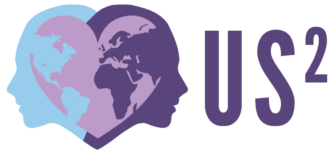Today, we’ll continue to explore sizeism from a few different lenses, with a goal of unmasking the hidden sources of implicit sizeism. Implicit sizeism, those subtle biases we hold about body size, often operate beneath our conscious awareness. They silently influence our perceptions, shaping how we see ourselves and others.
But here’s the challenge: recognizing sizeism can be difficult: it’s tough to notice if you never have. We get it though: acknowledging our own biases is hard work, but we’re in this together. Many folks have discovered their core beliefs beyond their learned biases and we believe that you can, too. We truly believe that you cannot do better in society until you know that you need to; no shame, blame, or guilt!
Acknowledge that you’ve been carrying these biases unknowingly. They’ve influenced your choices, your perceptions, and your interactions without us even realizing it. We’re inviting you into a chance to pull back the curtain and reveal those sources of implicit sizeism that have been operating behind the scenes.
Biases don’t come from nothing, even though they can seem like it. Today, we’ll explore some of the sources of implicit bias and how sizeism seeped its way into society. By sifting through education, media, family, culture, and experiences, we can start to see how sizeism became part of our everyday experience.
Get ready to explore, to challenge, and to grow. Together, we’re taking the first step towards a more inclusive world.
Shaping Early Beliefs
Education as a Seed of Bias
Education, the very foundation of knowledge and understanding, also plays a significant role in shaping our perceptions of body size. But how does it contribute to the challenge of implicit sizeism?
Curriculum Influence
The curriculum we follow in schools can inadvertently perpetuate size bias. For example, textbooks or educational materials may contain stereotypes or emphasize certain body types as the norm.
Teacher Attitudes Matter
Teachers, as influential figures in our lives, can either challenge or contribute to sizeism. Their attitudes and behaviors, even unintentional ones, can affect how students view themselves and others. Did you ever have teachers make comments that could be based in sizeism? Think about gym or health classes…
Peer Dynamics
Education is not just about books; it’s also about the people students interact with daily. Peer dynamics in schools can either reinforce or challenge size bias, making educational institutions a crucial battleground in the fight against bias.
Fostering Empathy Through Education
The Opportunity for Change
The opportunity within education lies in recognizing its role in perpetuating size bias and using this awareness as a catalyst for positive change.
Curriculum Reformation
We can advocate for changes in educational curricula to include more diverse and inclusive content, challenging size bias from an early age.
Teacher Training
Supporting teacher training programs that promote empathy and awareness of size bias can help educators become allies in the fight against implicit sizeism.
Promoting Inclusivity
By fostering inclusive environments and encouraging open conversations about sizeism in schools, we can empower the next generation to be more empathetic and accepting of diverse body sizes.
Education can be a powerful tool for challenging size bias. By recognizing its role and advocating for change within educational institutions, and by working to ensure our impact aligns with intentions, we can create a more inclusive future for all.
The Power of Portrayal
The Media’s Role in Shaping Biases
Mass media, from television to magazines to social media, has a powerful influence on how we perceive body size. But how exactly does it contribute to the challenge of implicit sizeism?
Media Stereotypes
Mass media often perpetuates harmful stereotypes about body size. For example, larger individuals may be portrayed in negative and limited roles, reinforcing size bias. Some actors and actresses have even been asked to gain and lose weight (or wear a fat suit) to emphasize an on-screen transformation.
Idealized Images
The media frequently promotes unrealistic body standards, leading to the perception that only certain body types are desirable or acceptable, further fueling sizeism.
Advertising Influence
Advertisements can unintentionally reinforce size biases by suggesting that products and lifestyles are linked to a particular body size, influencing consumer behavior and perceptions.
Challenging Size Bias Through Media Literacy
The Opportunity for Change
The opportunity within mass media lies in recognizing its impact on size bias and using this awareness to foster change.
Media Literacy Education
We can promote media literacy education to help individuals critically analyze and question the messages they receive from mass media, empowering them to challenge size bias. What images do we see on screens? Do they match reality?
Supporting Body Positivity Movements
Actively engaging with and supporting body positivity movements in media amplifies the voices that challenge unrealistic beauty standards and promote acceptance of diverse body sizes.
Media Representation Advocacy
By advocating for more diverse and inclusive media representation, we can encourage content creators to challenge sizeism and provide more accurate portrayals of people of all sizes.
Mass media may perpetuate size bias, but it also holds the potential for positive change. By raising awareness and acting within the media landscape, we can contribute to a more inclusive society for everyone.
Home & Beyond: Nurturing the Roots of Size Bias
Influence of Family and Culture
Our families and the cultures we grow up in play a significant role in shaping our beliefs and attitudes toward body size. But how do these sources contribute to the challenge of implicit sizeism?
Family Dynamics
Our families can unknowingly pass on size biases through their beliefs, attitudes, and behaviors. Hearing negative comments about body size from family members can influence our own perceptions. How many jokes have you heard about the Freshman 15 referring to college students returning home for a break?
Cultural Norms
Different cultures have varying perspectives on body size, and these norms can significantly impact our understanding of beauty and acceptability. These norms often favor specific body types, further fueling sizeism.
Religious and Social Influences
Religious and social communities may also have their own views on body size, affecting how individuals view themselves and others. These influences can shape our biases without us realizing it.
Embracing Cultural Diversity and Awareness
The Opportunity for Change
The opportunity within family and cultural beliefs lies in recognizing their role in perpetuating size bias and using this awareness to drive positive change.
Open Conversations
We can foster open conversations within our families and communities about size bias, challenging preconceived notions and promoting understanding. We can challenge the notion that weight gain automatically means lowered health.
Celebrating Cultural Diversity
Different cultures around the world celebrate different body sizes. By celebrating cultural diversity, we can encourage a broader acceptance of diverse body sizes, fostering an environment where everyone’s beauty is recognized.
Supporting Inclusive Initiatives
Actively supporting and engaging with initiatives and organizations that promote inclusivity challenges sizeism within various cultural and religious contexts.
Family and culture may be sources of size bias, but they can also be sources of change. By recognizing their influence and acting within these contexts, we can contribute to a more inclusive and accepting society.
Personal Experiences: Navigating the Impact of Size Bias in Real Life
How Our Experiences Shape Us
Personal experiences, whether positive or negative, have a profound influence on our perceptions of body size. But how do these experiences contribute to the challenge of implicit sizeism?
Direct Encounters
Interactions with others based on their body size can shape our perceptions and lead to bias. For example, if we’ve been subjected to hurtful comments about our own size, it may influence how we view others.
Influence of Social Media
In the digital age, social media platforms can both challenge and perpetuate sizeism, depending on the content we engage with. Scrolling through posts that shame or mock certain body types can contribute to bias.
Internalized Sizeism
Sizeism doesn’t just manifest externally. Internalized sizeism can get pretty dangerous and can lead to extreme dieting, mental health struggles, and eating disorders. Self-awareness is a key factor in overcoming bias, however, if you notice signs of an eating disorder in yourself or someone you care about, please contact a medical or mental health professional.
Fostering Personal Growth and Empathy
The Opportunity for Change
The opportunity within personal experiences lies in recognizing how they shape our biases and using this awareness as a stepping stone for positive change.
Awareness Leading to Empathy
Becoming aware of how our experiences have influenced us can lead to greater empathy for others who face size-based discrimination.
Influence on Media Consumption
By being mindful of the content we engage with on social media and actively seeking out diverse and body-positive voices, we can challenge sizeism in our online spaces.
Self-Reflection and Action
If you notice internalized sizeism and are in a healthy place, self-reflection is a great step towards challenging it. It’s a journey of continuous learning and growth. Remember to try to suspend shame and lean into grace and compassion.
Personal experiences can be both a source of bias and a source of personal growth. By recognizing their impact and taking action within our own lives, we can contribute to a more inclusive and empathetic world.
Our journey through the sources of implicit sizeism has illuminated how education, mass media, family, culture, and personal experiences shape our understanding of body size. Recognizing these sources is the first step towards change.
As we conclude this exploration, remember that our commitment to growth doesn’t end here. Continuing to be aware of these sources of bias and fostering empathy when we encounter them is how we create a world that celebrates diversity.
There’s more work to be done: our new challenge is to actively resist sizeism, not just within ourselves, but also in the world around us. Stay tuned for our next blog, where we’ll uncover practical steps for creating a more inclusive society around body size.
Want to stay updated on our journey towards a size-inclusive world? Subscribe to our newsletter and be part of the movement. Together, we can challenge biases, foster empathy, and create lasting change.




